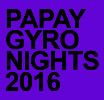 |
 |
 |
||||
 |
 |
|||||
 |
 |
|
|||||||||||||||||||||||
| THE NIGHT OF THE GYROS | ||
text from ORKNEYJAR - The Heritage of Orkney website The Gyro night traditions would appear to owe something to the creature of Scandinavian folklore known as Grýla. A variant of the many-tailed Gryla was recorded in Shetland, where she was latterly known as Skekla and rode a black horse “with 15 tails, and 15 children on each tail”. In Shetland and Faroe, Gryla, or her derivatives, were associated with costumed traditions involving female "monsters" which, disguised in tattered animal skins, straw or seaweed, visited farms on varying dates during the winter period to demand offerings. The Faroese grýlur, for example, appeared on the first Tuesday in Lent. One interesting old tradition, once celebrated every February, was found in the island of Papay. The last occurrence of "Gyro Night", however, was in 1914 and it is now but a memory. The actual date of "Gyro Night" is not found in any surviving account, but one reference indicates that the ceremony took place after the first full moon in February. This date connects the tradition with the Christian festival of Candlemas, as well as the Celtic celebration of Imbolc - an event marking the end of winter and the beginning of spring. But although we are not certain of the date, we do know that on Gyro Night the young boys of the island made torches, which they set alight before venturing out into the night. The object of their foray was to entice the "gyros" out of hiding. These gyros were usually the older lads, wearing masks and dressed as repulsive old women. If the torchbearers met a gyro, "she" would pursue the youngsters, striking at them with a piece of rope, or tangle, until they were able to outrun "her". The origin of the tradition is unclear, however it is likely that gyro derives from the Norse, gygr, meaning a giant, troll-woman. But what was the significance of this monstrous woman? The key appears to lie in an account that refers to the burning of a female effigy on Gyro Night. This seems to confirm that Gyro Night was connected to Imbolc, the Celtic celebration of winter's end. The fact that the tradition took place on Papay is particularly interesting, given the island's association with early Christianity. Imbolc was particularly associated with the pagan Celtic goddess Brigid and, in keeping with the policy of the early church to absorb pagan festivals into Christian feast-days, Brigid, became St Bride. St Bride's Day became equated with Candlemas on February 2 - the feast of the Purification of the Blessed Virgin Mary. So, the fires that were an integral part of the pagan festival - in particular the torchlight processions leading to a bonfire - were tamed down, with candles replacing the burning brands. Looking to Celtic tradition, we can begin to see information that appears to shed light on Papay's Gyro Night. For example, in the Scottish Highlands, and Ireland, an effigy of the spirit of winter - the Cailleach, or Old Wife, was burned on a bonfire. This wizened crone was thought to be reborn at Imbolc in the form of the goddess Brigid. Did the later Norse inhabitants of Papay incorporate these existing traditions, interpreting the old woman of winter as the ogress-like Gygr? The presence of traditions surrounding Brigid/Bride would seem to be borne out by the occurrence of 'Bride' placenames in Papay. But what of the connection to the Norse orgress? For that we need to look at the Celtic idea that the reborn goddess emerged from a burial mound. A Scottish rhyme about the Feast Day of Bride begins: This is the day of Bride, The queen will come from the mound… To the Norse Orcadians, the usual inhabitant of burial mounds was the monstrous creature known as the draugr. Over the centuries, the draugr beliefs degenerated into those of the trows and hogboon, but original fragments of lore hint that the mound's original inhabitant could often be found with his mother - a beast said to be even more terrible than her son. So do we have a situation where the islanders equated the Celtic hag in the mound with their ideas of a monstrous ogress dwelling in the howe? And was this the reason the Celtic night of the Goddess became equated with the Scandinavian gygr? Given the lack of other information about this lost tradition, speculation is all we have left. for more information about Orkney traditions visit www.orkneyjar.com |
 |
||
| PAPAY
GYRO NIGHTS ART FESTIVAL LTD is a
company registered in Scotland, registration number SC402686 PAPAY GYRO NIGHTS ART FESTIVAL. Tredwall, Papa Westray (Papay), Orkney KW17 2BU, Scotland / e: papaygyronights@papawestray.org |
| PAPAY GYRO NIGHTS ART FESTIVAL IS SUPPORTED BY: | ||
 |
| © PAPAY GYRO NIGHTS ART FESTIVAL 2013 |